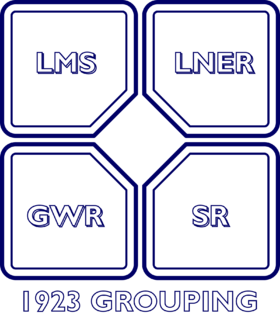Facts about the Great Western Railway (Wonder Book of Railways 14th ed)
| The "Big Four" railway companies |
|---|
 |
| Great Western Railway (GWR) |
| London, Midland and Scottish Railway (LMS) |
| London and North Eastern Railway (LNER) |
| Southern Railway (SR) |
A chapter about the Great Western Railway with useful facts and statistics, from the 14th edition of The Wonder Book of Railways (undated, but circa ~1925):
THE GREAT WESTERN RAILWAY
Seeing that the Great Western Railway is considerably larger than it was before grouping, it may be entitled to be described, as it was by a writer years ago, as the "Great" Great Western. But while the railway has become very much larger than it was, the additions were all relatively small concerns, principally in Wales. The largest of these was the Cambrian Railways, giving access to many beauty spots in Central Wales and on the Cambrian coast. But the busiest and most important were the South Wales coal lines, particularly the Taff Vale and Barry and Rhymney, though the Cardiff and Alexandra Docks Railways, chiefly because of their docks, were almost equally important. The acquisition of these lines has given the Great Western a nearly complete monopoly of the coal traffic of South Wales, though, judging by the large amounts of money which have been and are being spent on those lines, there can be no suggestion that South Wales will suffer because of this.
The original Great Western served essentially Devon and Cornwall, but it had equally important main routes to Birmingham, Shrewsbury, Chester and Birkenhead and to South Wales, besides good routes between Bristol and Chester via Hereford and Shrewsbury (partly joint with the London and North Western), from Bristol to Birmingham and south to Weymouth, whence its steamers plied, as they do to-day, to the Channel Islands.
It was the fashion at one time to interpret the initials G.W.R. as meaning "Great Way Round." During the last twenty years or so, however, so many short cuts have been made that Great Western trains usually now have the shortest, most direct or most convenient routes to most of the places the line Serves. Any idea that "monopoly" means poor facilities is discounted by the fact that a good proportion of the very fast trains for which the Great Western is now noted carry traffic which is not competitive.
From a tourist point of view, it is the Devon, Cornwall and Cambrian coast resorts which are principally served by the Great Western Railway. In the Bristol, Cardiff, Swansea, Newport and Birmingham districts, however, the Great Western has many exceedingly busy routes, and besides its tremendous coal traffic it does a great deal to assist industry in the "Black Country" and other areas.
The Great Western also sends many of its vehicles far off its own territory, as to the South Coast at Ramsgate and Margate, to Brighton and Hastings, to Southampton and Bournemouth, and as far north as Aberdeen, as well as to Liverpool, Manchester, York, Leeds, and other important towns. To provide for its huge coal exports it owns most of the finest docks in South Wales, and at Fishguard it has a splendid harbour, whence its steamers ply to Rosslare and Waterford, thus providing good routes to Ireland. It also operates steamers from Weymouth to the Channel Islands.
For working traffic over its 3,800 miles of line, there are nearly 4,000 locomotives, over 10,000 passenger train vehicles, and about 90,000 goods and mineral wagons of various types. In the course of a year about 140,000,000 passengers are conveyed, while some 60,000,000 tons of coal, 12,500,000 tons of other minerals and 14,000,000 tons of general goods traffic are carried. Great Western engines run nearly 100,000,000 miles in the course of twelve months.
— -, The Railway "Big Six", The Wonder Book of Railways, 14th edition


